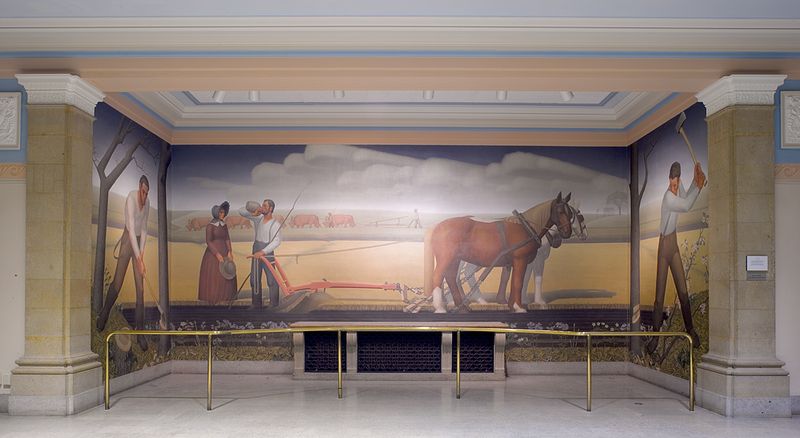
About the Art
Breaking the Prairie Sod was commissioned by Iowa State College as a joint project of the federal Works Progress Administration (WPA), the National Youth Administration (NYA) and Iowa State College for the Iowa State Library. The three-panel mural tells the story of the settlement of Iowa in the 1840s, which began with turning the prairie soil and romanticizes the rural and simple people heroically struggling with nature to produce the nation’s harvest. An interesting detail is the man in the left panel who does not sweat despite chopping down a tree.
The mural, installed between 1936-1937, is a tribute to the founding of land-grant colleges, including Iowa State Agricultural College and Model Farm in 1858. President Abraham Lincoln played a vital role in the development of land-grant colleges; he signed the Morrill Act in 1862, which established federal funds for the purchase of land in each state for the purpose of higher education. Iowa was the first state to accept the provisions of the law. The funds were awarded to Iowa State Agriculture College and Model Farm, now Iowa State University, making it the first land-grant institution in the United States. The figures in the two side panels who are chopping the trees and clearing the fields resemble future President Lincoln. President Lincoln influenced the development of agriculture in the Midwest, brought human settlement to the prairie, and helped cultivate central Iowa with the establishment of what would become a university. With Breaking the Prairie Sod permanently installed in the lower lobby of the Parks Library, visitors can view the history of Iowa and agriculture in early America.
About the Artist
Grant Wood (1891 – 1942) was an artist from Iowa and a member of the Regionalist movement in American art. From 1922 to 1928, Wood made four trips to Europe, where he studied many styles of painting, especially Impressionism and post-Impressionism. However, it was the work of the 15th-century Flemish artist Jan van Eyck that influenced him to take on his own technique. He began to paint in the sharply detailed, realistic manner in his new works that he is known for today. The compositional severity and detailed techniques are derived from Northern Renaissance paintings, which Wood had looked at during his visits to Europe. As a result, Wood became increasingly aware of the Midwest’s own legacy, which also informs the work. This idea became known as Regionalism, which championed the solid rural values of central America against the complexities of European-influenced East Coast Modernism.
Wood’s best-known art is his 1930 painting American Gothic, which is also one of the most famous paintings in American art and one of the few images to reach the status of widely recognized cultural icon. American Gothic caused a sensation when it was exhibited at the Art Institute of Chicago due to the hard, cold realism, honest, and earthy quality of its subject as it was unusual in American art. Although his most famous painting is artificially staged, complex, and ambivalent, it is a telling portrait of the sober and hardworking rural dwellers of the Midwest. As a Regionalist painter, he created a style of art that will be forever known and remembered as American art. Below are this iconic painting and examples of other famous works by Grant Wood.

American Gothic, 1930, The Art Institute of Chicago, Chicago, Illinois
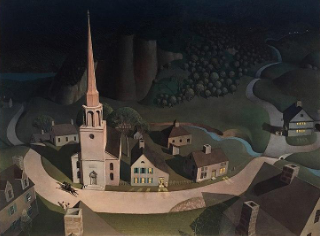
The Midnight Ride of Paul Revere, 1931, Metropolitan Museum of Art, New York, NY
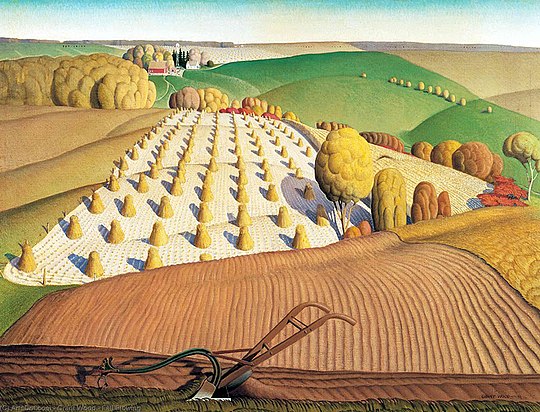
Fall Plowing, 1931, John Deere Corporation, Moline, Illinois
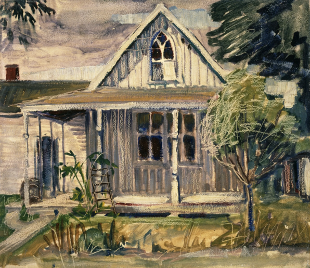
Sketch for house in “American Gothic,” 1930, Smithsonian American Art Museum, Washington DC
Relevant Terminology/History
Works Project Administration (WPA) was established during the Depression that followed the stock market crash in 1929. Thousands of businesses and banks failed resulting in a quarter of the American workforce becoming unemployed. An unintended benevolent consequence of the economic hardships of the times was that attendance at many American museums reached an all time high. The appeal of free museum admissions for families with little to no money attracted many Americans who, for the first time, were exposed to and appreciated works of art. In 1933, President Franklin D. Roosevelt and his New Deal heightened the awareness for public art, the employment relief needs of artists, and the creation of artwork for newly constructed federal buildings.
Land-Grant Act /Morrill Act (1862) was introduced in the Senate as S. 298 by Justin Smith Morrill (R-VT) on May 5, 1862, and signed into law by President Lincoln on July 2, 1862. The Act donated Public Lands to states to establish public colleges. As a result, over 10 million acres were expropriated from tribal lands of Native communities. The new land-grant institutions, which emphasized agriculture and mechanic arts, opened opportunities to thousands of farmers and working people who were previously excluded from achieving a higher education.
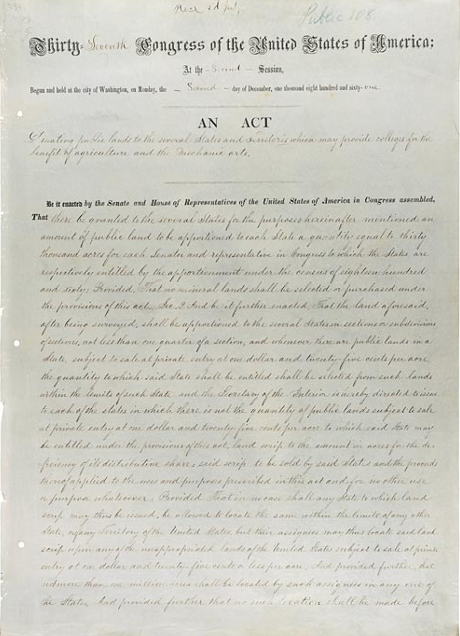
Image of the Morrill Act, 1862, General Records of the United States Government, National Archives, Washington, DC
*Fun Fact: Iowa was the first state to request land grant funds to set aside land for Iowa colleges, including what is not ISU.
Learning Guide

- What do you think the title has to do with the art?
- Why do you think Number Character 0 is speaking about the art?
- How does the red image with white numbers relate to the art?
- How does the hidden blue image relate to the art? Can you find it in the art?
- Do you think the art is installed flat on one wall?
- Why do you think the spread image in the book includes small inserts of a man cutting a tree on the left and right?
- How many horses do you see in Breaking the Prairie Sod? How did you decide the quantity?
- Do the images of the men cutting the trees remind you of anyone?
- Look at the man drinking from a jug. How is he doing it? Could you do it?
- Look at the woman in the field. What do you think about her clothing while she is out in the field? What would a woman today likely wear?
- Do you think the WPA was a good idea? Should we have a new WPA? Why?
- Which US president signed the Morrill Act?
- Why was the Land-Grant Act officially named the Morrill Act?
- Why do you think the two people in American Gothic look so dour?
